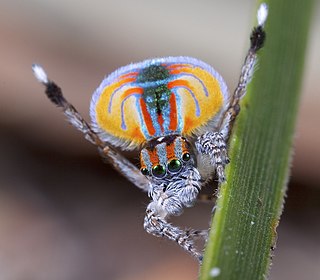
Sir David Frederick Attenborough is an English broadcaster, biologist, natural historian and author. He is best known for writing and presenting, in conjunction with the BBC Natural History Unit, the nine natural history documentary series forming the Life collection, a comprehensive survey of animal and plant life on Earth.

Oonopidae, also known as goblin spiders, is a family of spiders consisting of over 1,600 described species in about 113 genera worldwide, with total species diversity estimated at 2000 to 2500 species. The type genus of the family is OonopsKeyserling, 1835.

Sir David's long-beaked echidna, also known as Attenborough's long-beaked echidna or the Cyclops long-beaked echidna, is one of the three species from the genus Zaglossus that occurs in New Guinea. It is named in honour of naturalist Sir David Attenborough. It lives in the Cyclops Mountains, which are near the cities of Sentani and Jayapura in the Indonesian province of Papua.

Maratus is a spider genus of the family Salticidae. These spiders are commonly referred to as peacock spiders due to the males' colorful and usually iridescent patterns on the upper surface of the abdomen often enhanced with lateral flaps or bristles, which they display during courtship. Females lack these bright colors, being cryptic in appearance. In at least one species, Maratus vespertilio, the expansion of the flaps also occurs during ritualised contests between males. The male display and courtship dance are complex, involving visual and vibratory signals.

Robert Whyte is an Australian writer. He was a founding co-owner and director of the Brisbane-based multimedia firm ToadShow. After 2012 he participated in the Australian Government's new species exploration program Bush Blitz. His works include The Creek in Our Back Yard: a practical guide to creek restoration (2011) and A Field Guide to Spiders of Australia for CSIRO Publishing 2017.
Ctenocheloides is a genus of ghost shrimp in the family Callianassidae, containing the single species Ctenocheloides attenboroughi. It was described in 2010, and named in honour of the British natural history broadcaster Sir David Attenborough. It is known from a single female specimen collected in shallow water on the north-western coast of Madagascar.
Prethopalpus is a spider genus known as goblin spiders and are found in the Australasian tropics, including Nepal, India, Indonesia, Papua New Guinea and Australia. Three species are widely distributed, whereas the majority of species are recorded a single localities. Of the 41 species, 14 blind troglobite species live in subterranean ecosystems in Western Australia.
Prethopalpus maini is a subterranean goblin spider in the family Oonopidae.

Cavisternum is a genus of goblin spider. All its species are native to Australia.
Opopaea is a genus of goblin spiders of the family Oonopidae. The genus is one of the largest within the family, with 180 accepted species.
Prethopalpus blosfeldsorum is a litter-dwelling goblin spider in the family Oonopidae.
Prethopalpus marionae is a litter-dwelling goblin spider in the family Oonopidae.

Tamopsis is a genus of tree trunk spiders that was first described by B. Baehr & M. Baehr in 1987. Like other members of the family, they may be called two-tailed spiders, referring to two elongated spinnerets. The name is derived from the genus Tama and the Ancient Greek ὄψις, meaning "resembling".

Microleo attenboroughi is a very small species of the Thylacoleonidae family of marsupials from the Early Miocene of Australia, living in the wet forest that dominated Riversleigh about 18 million years ago. The genus Microleo is currently known from a broken palate and two pieces of jaw, containing some teeth and roots that correspond to those found in other species of thylacoleonids. The shape and structure of the blade-like P3 tooth, a premolar, distinguished the species as a new genus. It was found in Early Miocene-aged deposits of the Riversleigh fossil site in Queensland, regarded as one of the most significant palaeontological sites yet discovered, and named for the naturalist David Attenborough in appreciation of his support for its heritage listing. The anatomy of Microleo suggests the genus is basal to all the known thylacoleonids, known as the marsupial lions, although its relative size prompted one discoverer to describe it as the "feisty" kitten of the family.

Pristimantis attenboroughi, also known as Attenborough's rubber frog, is a species of frog in the family Strabomantidae. It is endemic to the Peruvian Andes and has been recorded in and near the Pui–Pui Protection Forest. It is the first amphibian named after David Attenborough. It was discovered by Edgar Lehr and Rudolf von May during a period of two years of studying the forests of Peru. The species description was based on 34 specimens caught at elevations of 3,400–3,936 m (11,155–12,913 ft) above sea level.
Barbara Baehr is a German research scientist, entomologist, arachnologist, and spider taxonomist. She has described over 400 new spider species, mostly from Australia. She is originally from Pforzheim, Germany.
Cichlidogyrus attenboroughi is a species of monopisthocotylean monogeneans in the family Dactylogyridae. It is a parasite of the gills of the fish Benthochromis horii in Lake Tanganyika.
Sir David Attenborough's myotis is a species of small bat in the family Vespertilionidae that is endemic to the Caribbean island of Tobago. Its presence on nearby Trinidad is as yet uncertain. It is the only mammal species currently known to be endemic to Trinidad and Tobago. It was named after famed English naturalist Sir David Attenborough.








